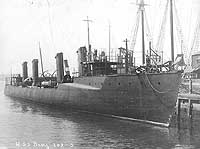
USS Barry, a 420-ton Bainbridge class destroyer, was built at Philadelphia, Pennsylvania. She was commissioned in late November 1902 and served for the next year with the North Atlantic Fleet. With four of her sister destroyers, Barry steamed across the Atlantic, transited the Mediterranean and the Suez Canal and crossed the Indian Ocean and the South China Sea between December 1903 and April 1904. For the next thirteen years she served in the Far East, operating off China and in the Philippine Islands.
In August 1917, some months after the United States entered World War I, Barry retraced her route to reinforce the anti-submarine effort in European waters. After nearly a year of convoy escort and patrol service in the vicinity of Gibraltar, she returned to the United States and was based at Charleston, South Carolina until after the November 1918 Armistice. Barry was stationed at Philadelphia, Pennsylvania, from January 1919 until she decommissioned in late June. She was sold at the beginning of 1920.
USS Barry was named in honor of Commodore John Barry (1745-1803), one of the most important leaders of the early United States Navy.
This page features all the views we have related to USS Barry (Destroyer # 2).
| If you want higher resolution reproductions than the digital images presented here, see: "How to Obtain Photographic Reproductions." |
Click on the small photograph to prompt a larger view of the same image.
|
Photo #: NH 498 USS Barry (Destroyer # 2) Photographed in port soon after completion, circa 1902-1903. U.S. Naval Historical Center Photograph. Online Image: 95KB; 740 x 575 pixels |
 |
|
Photo #: NH 98140 USS Barry (Destroyer # 2) Alongside the Sheer Wharf at Cavite Navy Yard, Philippines, circa 1910-1913. Collection of Phillip H. Wilson. Donated by Mrs. Pauline M. Wilson, 1979. U.S. Naval Historical Center Photograph. Online Image: 111KB; 740 x 460 pixels |
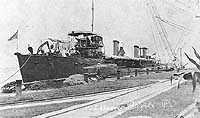 |
|
Photo #: NH 90178 USS Barry (Destroyer # 2) Coaling at the Cavite Navy Yard, Philippine Islands, circa 1912. Collection of Phillip H. Wilson. U.S. Naval Historical Center Photograph. Online Image: 82KB; 440 x 765 pixels |
 |
|
Photo #: NH 56348 USS Barry (Destroyer # 2) At the Charleston Navy Yard, South Carolina, circa late 1918. U.S. Naval Historical Center Photograph. Online Image: 85KB; 740 x 605 pixels |
 |
|
Photo #: NH 98599-KN (color) "First Torpedo Flotilla. During a Storm in the Mediterranean en-route to China February 23, 1904" Painting by an unidentified artist, depicting the destroyers Bainbridge, Barry, Chauncey, Dale and Decatur in heavy seas. Courtesy of the U.S. Navy Art Collection, Washington, D.C. Donation of Mrs. Anne Garagusi, 1981. U.S. Naval Historical Center Photograph. Online Image: 92KB; 740 x 530 pixels |
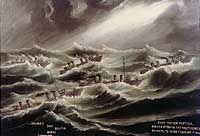 |
|
Photo #: NH 52102 First Torpedo Flotilla Steaming in close formation off Chefoo, China, in 1905, while under the command of Lieutenant Dudley W. Knox. Ships present are (as numbered): 1. USS Decatur (Destroyer # 5); 2. USS Dale (Destroyer # 4); 3. USS Barry (Destroyer # 2); 4. USS Chauncey (Destroyer # 3); and 5. USS Bainbridge (Destroyer # 1). Donation of Mrs. J.R. Kean, 1938. Courtesy of Captain Dudley W. Knox, USN (Retired). U.S. Naval Historical Center Photograph. Online Image: 95KB; 740 x 600 pixels |
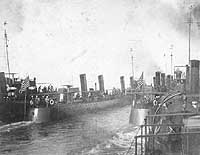 |
|
Photo #: NH 52103 First Torpedo Flotilla Forming a "wedge" formation while steaming off Chefoo, China, during the summer of 1905. Photographed from USS Dale (Destroyer # 4). The other ships present are (as numbered): 1. USS Decatur (Destroyer # 5); 2. USS Barry (Destroyer # 2); 3. USS Chauncey (Destroyer # 3); and 4. USS Bainbridge (Destroyer # 1). The Flotilla was commanded by Lieutenant Dudley W. Knox. Donation of Mrs. J.R. Kean, 1938. Courtesy of Captain Dudley W. Knox, USN (Retired). U.S. Naval Historical Center Photograph. Online Image: 78KB; 560 x 765pixels |
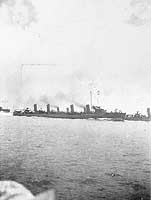 |
|
Photo #: NH 88584 USS Chauncey (Destroyer # 3) and USS Barry (Destroyer # 2) Anchored in Philippine waters, circa 1914-1916. Collection of C.A. Shively. U.S. Naval Historical Center Photograph. Online Image: 60KB; 740 x 505 pixels |
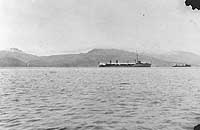 |
|
Photo #: NH 43036 Philadelphia Navy Yard, Pennsylvania Destroyers awaiting decommissioning in the Navy Yard's Reserve Basin, during the Spring of 1919. Photographed by La Tour. Ships present are identified in Photo # NH 43036 (complete caption). U.S. Naval Historical Center Photograph. Online Image: 80KB; 740 x 500 pixels |
 |
|
Photo #: NH 92301 Philadelphia Navy Yard, Pennsylvania Old destroyers in the Reserve Basin, 13 June 1919, while awaiting decommissioning. Note the truck and liferafts on the pier. These ships are (from left to right): USS Worden (Destroyer # 16); USS Barry (Destroyer # 2); USS Hull (Destroyer # 7); USS Hopkins (Destroyer # 6) -- probably; USS Bainbridge (Destroyer # 1); USS Stewart (Destroyer # 13); USS Paul Jones (Destroyer # 10); and USS Decatur (Destroyer # 5). Ships further to the right can not be identified. Courtesy of Frank Jankowski, 1981. U.S. Naval Historical Center Photograph. Online Image: 117KB; 740 x 595 pixels |
 |
|
Photo #: NH 54148 First Torpedo Flotilla Group photograph of most of the Flotilla's officers, on board USS Chauncey (Destroyer # 3). Taken at the Norfolk Navy Yard, Virginia, in late 1903, shortly before the Flotilla left for its voyage to the Philippines. Those present are identified in Photo # NH 54148 (complete caption). U.S. Naval Historical Center Photograph. Online Image: 72KB; 740 x 465 pixels |
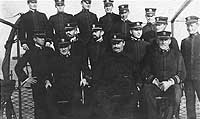 |
The following photograph shows a ship that MAY be USS Barry (Destroyer # 2):
| If you want higher resolution reproductions than the digital images presented here, see: "How to Obtain Photographic Reproductions." |
Page made 7 September 2002
New image added 18 July 2003